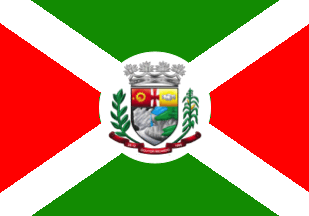Doutor Ricardo, Rio Grande do Sul (Brazil) (original) (raw)

This page is part of © FOTW Flags Of The World website
Last modified: 2020-07-18 by ian macdonald
Keywords: [rio grande do sul](keywordr.html#rio grande do sul) | [doutor ricardo](keywordd.html#doutor ricardo) |
Links: FOTW homepage |search | disclaimer and copyright | write us | mirrors
 image by Ivan Sache, 17 July 2020
image by Ivan Sache, 17 July 2020
- Municipality
- Symbols
- Escola Municipal de Educa��o Infantil Amiguinhos do Coracao See also:
- Municipal Flags of Rio Grande do Sul
- State of Rio Grande do Sul
- Brazilian Municipal Flags
- Brazil
Municipality
The municipality of Doutor Ricardo (2,074 inhabitants in 2016; 10,828 ha) is located 170 km of Porto Alegre.
The municipality of Doutor Ricardo was established by State Law No. 10,639 promulgated on 28 December 1995, separating from Encantado and Anta Gorda, and inaugurated on 1 January 1997.
The town's namesake is Dr Ernesto Ricardo Heinzelmann (1820-1890). Born in Germany, he studied medicine there and moved to Brazil, where he defended his thesis. Dr. Ricardo served as chief of the medical services during the cholera epidemics that scoured Rio de Janeiro in 1855 and 1856. As a reward for his successful management of the disease, the imperial government offered him a plot, of unknown exact location, but surely part of the subsequent district of Doutor Ricardo. The doctor never took possession of his domain, preferring to stay in Porto Alegre where he died in relative oblivion. Neither would his children, who went back to Germany.
https://doutorricardo.rs.gov.br/prefeito-recebe-documento-historico-de-doutor-ricardo
Municipal website
In the Gauch� communities established by Italian immigrants in the mountains of Rio Grande do Sul, women used to produce flax thread ("fil�") in collective workshops; to make hard work more pleasant, they started to bring food and organized parties. "fil�" was soon used to name informal meetings during which the colonists shared their experience and difficulties - the area was not the promised land they had been "sold" by the organizers of the colonization but a wild environment with little resource and absolutely not the least external support. This was also the only opportunity of social exchange: gossiping, dating etc...
"Fil�" is now a big festival highlighting the sacrifice of the early colonists for the development of the area and promoting Italian heritage, dialects included, and, first of all, traditional polenta.
https://gauchazh.clicrbs.com.br/geral/noticia/2016/06/descubra-o-que-significa-filo-para-a-cultura-italiana-cj5wc7r2t1l2vxbj09f2v1tfp.html
Gauch�zh Geral, 4 June 2016
Ivan Sache, 17 July 2020
Description of the Flag
Escola Municipal de Educa��o Infantil Amiguinhos do Coracao
[ ![[Flag of Escola Municipal de Educa��o Infantil Amiguinhos do Coracao, Rio Grande do Sul (Brazil)]](http://www.crwflags.com/fotw/images/b/br_dfadc.gif) ](../images/b/br%5Fdfadc.gif) image by Ivan Sache, 17 July 2020
](../images/b/br%5Fdfadc.gif) image by Ivan Sache, 17 July 2020